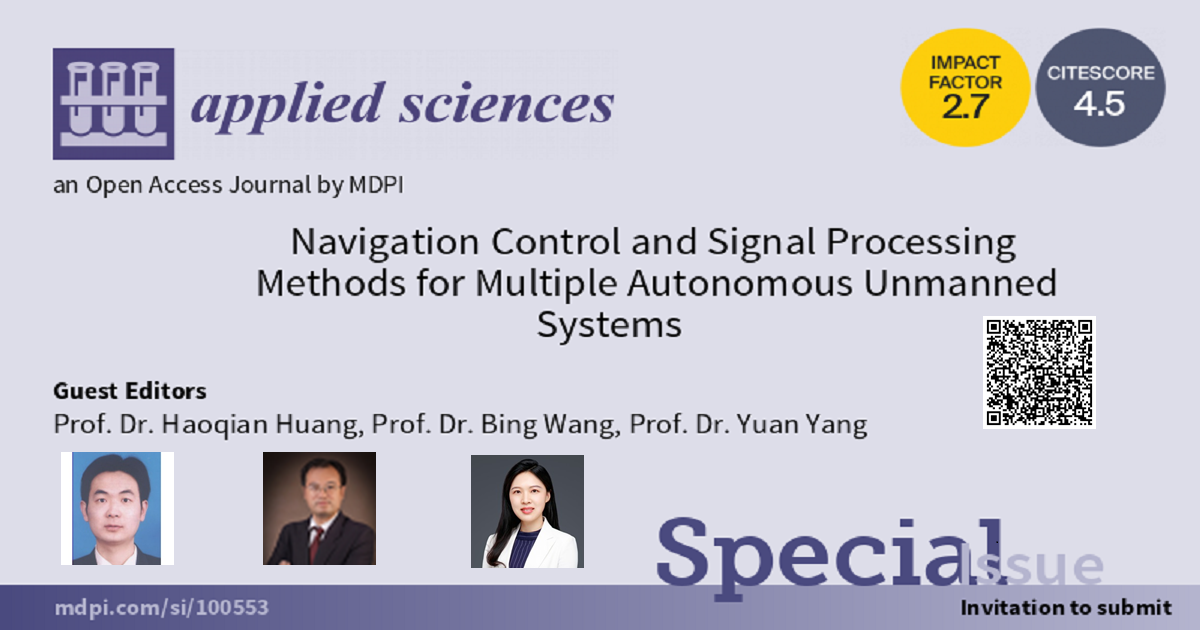Navigation Control and Signal Processing Methods for Multiple Autonomous Unmanned Systems
A special issue of Applied Sciences (ISSN 2076-3417). This special issue belongs to the section "Robotics and Automation".
Deadline for manuscript submissions: closed (31 July 2023) | Viewed by 14084

Special Issue Editors
Interests: Integrated navigation, filtering, underwater vehicle; intelligent sensor
Interests: intelligent sensor; nonlinear networked control and application
Special Issues, Collections and Topics in MDPI journals
Interests: precise measurement; measurement and fusion technology; filtering method
Special Issues, Collections and Topics in MDPI journals
Special Issue Information
Dear Colleagues,
Underwater unmanned system refers to underwater unmanned control systems with certain autonomous capacity and autonomy, which is a combination of artificial intelligenceand real-time control decision systems. Underwater unmanned system integrates a multi-discipline advanced technology such as power, mobile, control, sensor, and artificial intelligence. It is a typical product of mechanized information intelligence and high integration and military and civilian technology. It has been successfully applied to submarine pipeline layoutand exploration, marine mineral resources exploration, marine biological resources survey, submarine reconnaissance, submarine training and other fields. In recent years, the development of sensor technology, control theory, artificial intelligence, signal processing algorithm has promoted the continuous improvement of underwater unmanned system navigation technology, and there have been a variety of novel underwater navigation methods. In summary, underwater unmanned system navigation technology can be divided into the following categories: (1) Inertial navigation: the inertial navigationsystem is based on INS and supplemented by other navigation.INS and DVL combination navigation are important autonomous navigation methods forunderwater unmanned systems; (2) Passive navigation: the geophysical navigation has the characteristics of good concealment and no need to surface for calibration. Itis a research focus for underwater unmanned system; (3) Beacon Navigation: this navigation method applies the sonobuoy underwater positioning navigation system based on GPS to the underwater robot, which can make up for the shortcomings such as the inability to move the array position in the long baseline and the lack of surface and underwater communication ability.
Underwater unmanned system is a multi-disciplinary integrated system. To solve its core problems such as autonomy, interoperability, data link and multi-platform collaboration, the following common key technologies need to be broken through: (1) Autonomous navigation technique: in order to ensure that the AUV can complete various tasks in the complex marine environment autonomously and collaboratively. It is necessary to solve technical problems such as environmental adaptation, autonomous docking and recovery, cooperative control of formation, cooperative navigation and positioning, etc. (2) Underwater data link communication technology: in order to achieve data sharing between multi-platform underwater unmanned systems, we must solve the problem of technical problems such as underwater remote high-speed communication, underwater network and air network interconnection.
This special issue aims to provide advanced control, navigation and signal processing methods for multiple autonomous unmanned systems.
Potential topics to be covered:
- New investigation methods and sensors for path planning;
- Compensation and calibration algorithms for navigation sensors;
- Advanced sensors and information fusion for underwater navigation;
- Underwater image enhancement and 3D image reconstruction;
- Mobile robot navigation and control based on intelligent learning / bionics;
- Cooperative control and navigation in multi-unmanned systems;
- Quantum device and intelligent measurement;
- Bionic navigation sensors;
- New-concept navigation: Brain-like navigation, signals of opportunity navigation;
- Underwater data link communication technology;
Prof. Dr. Haoqian Huang
Prof. Dr. Bing Wang
Prof. Dr. Yuan Yang
Guest Editors
Manuscript Submission Information
Manuscripts should be submitted online at www.mdpi.com by registering and logging in to this website. Once you are registered, click here to go to the submission form. Manuscripts can be submitted until the deadline. All submissions that pass pre-check are peer-reviewed. Accepted papers will be published continuously in the journal (as soon as accepted) and will be listed together on the special issue website. Research articles, review articles as well as short communications are invited. For planned papers, a title and short abstract (about 100 words) can be sent to the Editorial Office for announcement on this website.
Submitted manuscripts should not have been published previously, nor be under consideration for publication elsewhere (except conference proceedings papers). All manuscripts are thoroughly refereed through a single-blind peer-review process. A guide for authors and other relevant information for submission of manuscripts is available on the Instructions for Authors page. Applied Sciences is an international peer-reviewed open access semimonthly journal published by MDPI.
Please visit the Instructions for Authors page before submitting a manuscript. The Article Processing Charge (APC) for publication in this open access journal is 2400 CHF (Swiss Francs). Submitted papers should be well formatted and use good English. Authors may use MDPI's English editing service prior to publication or during author revisions.







